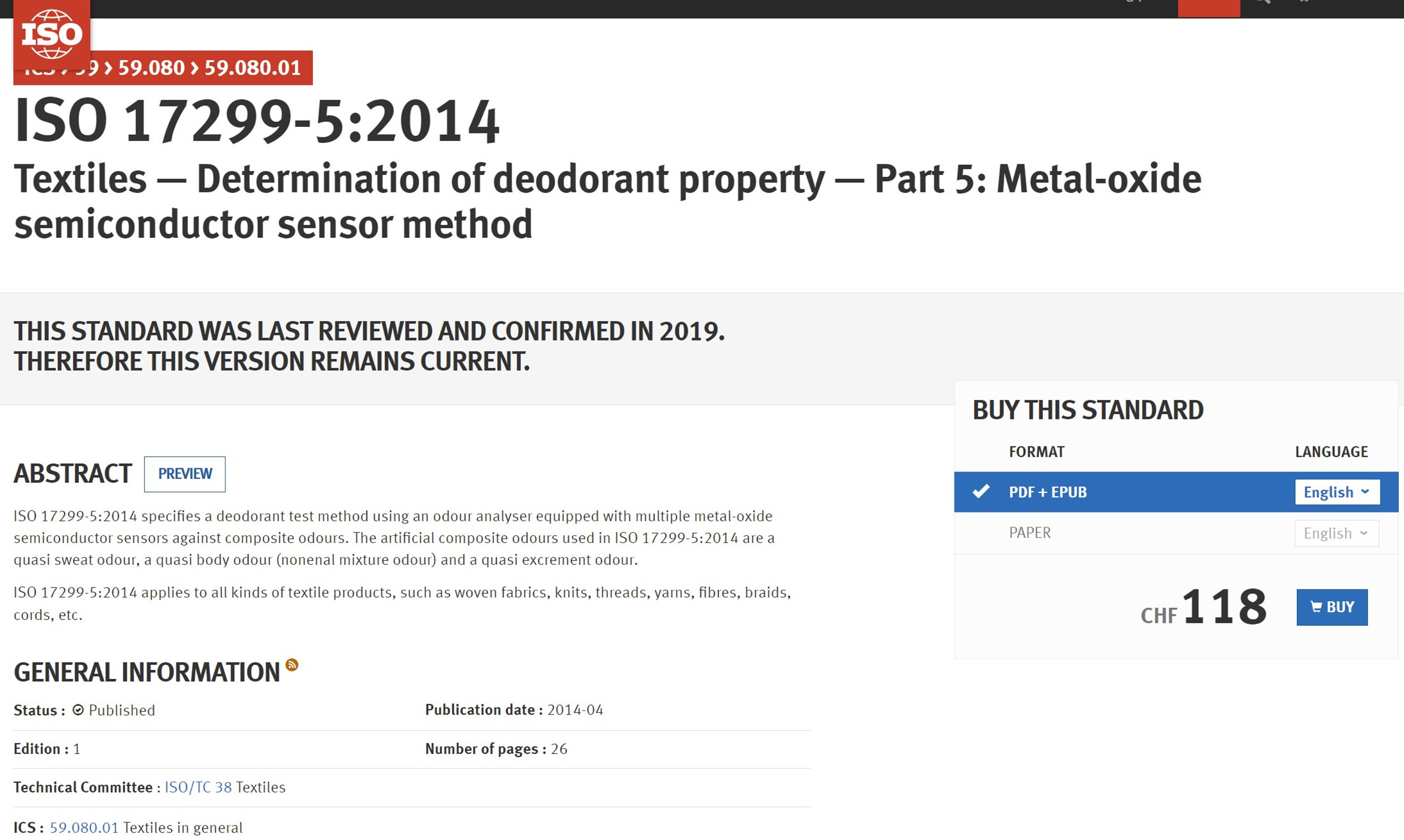纺织品除臭性能的测定 第5部分:金属氧化物半导体传感器法
时间:2022-03-07 15:26:00 来源:ISO 点击量:

ISO 17299-5:2014
Textiles — Determination of deodorant property — Part 5: Metal-oxide semiconductor sensor method
Introduction
This part of ISO 17299 describes a test method using a testing instrument equipped with multiple metal-oxide semiconductor sensors against composite odours for all textiles. The multiple sensors improve accuracy for several kinds of composite odours.
1 Scope
This part of ISO 17299 specifies a deodorant test method using an odour analyser equipped with multiple metal-oxide semiconductor sensors against composite odours. The artificial composite odours used in this part of ISO 17299 are a quasi sweat odour, a quasi body odour (nonenal mixture odour) and a quasi excrement odour.
This part of ISO 17299 applies to all kinds of textile products, such as woven fabrics, knits, threads, yarns, fibres, braids, cords, etc.
2 Normative references
ISO 17299-1, Textiles — Determination of deodorant property — Part 1: General principle
3 Terms and definitions
For the purposes of this document, the following terms and definitions apply.
3.1
quasi unpleasant odour
artificial composite odour used to simulate an unpleasant odour
Note 1 to entry: Artificial composite odours for the purpose of this part of ISO 17299 are as follows:
— quasi sweat odour: ammonia, acetic acid, isovaleric acid;
— quasi body odour (nonenal mixture odour): ammonia, acetic acid, isovaleric acid, nonenal;
— quasi excrement odour: ammonia, acetic acid, hydrogen sulfide, methyl mercaptan, indole.
3.2
odour unit concentration
concentration defined as the rate of the odour chemical concentration in μl/l against the olfactory threshold concentration
Note 1 to entry: It is expressed in OU/m3.
3.3
olfactory threshold concentration
minimum concentration at which human could perceive
Note 1 to entry: Olfactory threshold concentration value of the odour chemical substances used in this part of ISO 17299 is shown in Table 1.
Note 2 to entry: See Reference [1] in the Bibliography.
3.4
metal-oxide semiconductor sensor
sensor using a metal-oxide semiconductor made of e.g. tin dioxide
Note 1 to entry: The response of sensors corresponds to gas chemical concentration. The blend recipe of the constituent metal-oxide gives different response trend to chemicals.
3.5
odour test instrument
instrument equipped with multiple metal-oxide semiconductor sensors
Note 1 to entry: This instrument is built up with the inlet of the testing gas, sensors, and cleaning system of sensor head.
3.6
response value
value obtained as outputs from sensors
3.7
response vector
vector for a quasi unpleasant odour consisting of response value obtained from each sensor separately
3.8
response vector length
length obtained as vector sum which is calculated as square-root of sum of squares of response values
Note 1 to entry: The length represents a proportional amount of chemical concentration.
3.9
calibration curve
curve that determines odour unit concentration corresponding to response vector length
Note 1 to entry: The quadratic curve is used for this calibration curve derived from Reference [2] as proximity.
CIAA会员单位免费下载

